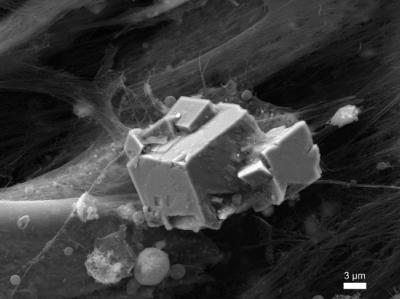A new biomaterial that facilitates generating bone tissue - artificial bones, in their words - from umbilical cord stem cells has gotten a patent for researchers in Granada, Spain.
The material is an activated carbon cloth support for cells that differentiate, giving rise to a product that can promote bone growth. They received a patent though the method has not yet been applied using in vivo models but it could help manufacture medicines for the repair of bone or osteochondrial, tumour or traumatic lesions and to replace lost cartilage in limbs.
Now that they have obtained artificial bones in the laboratory, they are going to implant this biomaterial in experimental animal models to see if it can regenerate bone in them.

"Artificial bone", or mineralization of the extracellular matrix, obtained by the Granada-based scientists. Credit: University of Granada
The scientists behind it are from the Biomedical Research Centre and the Faculties of Sciences of the Universities of Granada and Jaén, and the Spanish National Research Council Institute of Parasitology and Biomedicine "López Neyra". As they explained, no alternative materials are currently available on the market, nor have any been described in the literature. Precedents exist in the development of materials that fulfill the basic function of stimulating cell differentiation but a biologically complex material similar to bone tissue has never before been produced "ex vivo".
The method of stem cell differentiation developed in Granada uses a three-dimensional support and facilitates obtaining cell types implicated in bone regeneration in cell culture conditions not requiring additional differentiation factors or factors that differ from those present in the cell culture serum. In other words, thanks to this invention, a biomaterial consisting of stem cells supported on activated carbon cloth and capable of generating a product in which osteochondrial and mineralized extracellular organic matrix lineage cells exist, can be obtained.
The patent developed in Granada could have numerous applications in stem cell use in regenerative medicine, as well as in treating bone tissue and cartilage lesion problems.
Following this finding, the researchers are confident of obtaining the finances needed to be able to continue their work and achieve the ultimate objective of their invention: to regenerate bones by implanting biomaterial in patients with pathologies affecting the osseous system.
Presented during a press conference at the Biomedical Research Centre held in Granada.





Comments